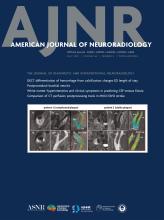This article requires a subscription to view the full text. If you have a subscription you may use the login form below to view the article. Access to this article can also be purchased.
Abstract
BACKGROUND AND PURPOSE: The diagnostic performance of deep learning model that simultaneously detecting and quantifying nigrosome-1 abnormality by using susceptibility map-weighted imaging (SMwI) remains unexplored. This study aimed to develop and validate a deep learning-based automatic quantification for nigral hyperintensity and a classification algorithm for neurodegenerative parkinsonism.
MATERIALS AND METHODS: We retrospectively collected 450 participants (210 with idiopathic Parkinson disease [IPD] and 240 individuals in the control group) for training data between November 2022 and May 2023, and 237 participants (168 with IPD, 58 with essential tremor, and 11 with drug-induced parkinsonism) for validation data between July 2021 and January 2022. SMwI data were reconstructed from multiecho gradient echo. Diagnostic performance for diagnosing IPD was assessed by using deep learning–based automatic quantification (Heuron NI) and classification (Heuron IPD) models. Reference standard for IPD was based on N-3-fluoropropyl-2-β-carbomethoxy-3-β-(4-iodophenyl) nortropane PET finding. Additionally, the correlation between the Hoehn and Yahr (H&Y) stage and volume of nigral hyperintensity in patients with IPD was assessed.
RESULTS: Quantification of nigral hyperintensity by using Heuron NI showed an area under the curve (AUC) of 0.915 (95% CI, 0.872–0.947) and 0.928 (95% CI, 0.887–0.957) on the left and right, respectively. Classification of nigral hyperintensity abnormality by using Heuron IPD showed area under the curve of 0.967 (95% CI, 0.936–0.986) and 0.976 (95% CI, 0.948–0.992) on the left and right, respectively. H&Y score ≥3 showed smaller nigral hyperintensity volume (1.43 ± 1.19 mm3) compared with H&Y score 1–2.5 (1.98 ± 1.63 mm3; P = .008).
CONCLUSIONS: Our deep learning–based model proves rapid, accurate automatic quantification of nigral hyperintensity, facilitating IPD diagnosis, symptom severity prediction, and patient stratification for personalized therapy. Further study is warranted to validate the findings across various clinical settings.
ABBREVIATIONS:
- AUC
- area under the curve
- CNN
- convolutional neural network
- DIP
- drug-induced parkinsonism
- ET
- essential tremor
- H&Y
- Hoehn and Yahr
- ICV
- intracranial volume
- IPD
- idiopathic Parkinson disease
- 18F-FP-CIT
- N-3-fluoropropyl-2-β-carbomethoxy-3-β-(4-iodophenyl) nortropane
- SMwI
- susceptibility map–weighted imaging
- SN
- substantia nigra
- QSM
- quantitative susceptibility mapping
- © 2025 by American Journal of Neuroradiology












